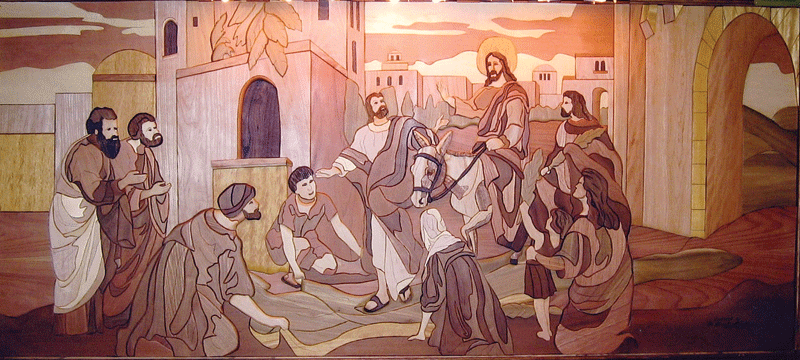
Editor’s note: As Palm Sunday draws near, the Diocese of Charleston continues to celebrate Mass and reach out in faith online. Palm Sunday Mass will be live-streamed from the Chapel of the Holy Family on April 5, in English at 11 a.m. and in Spanish at 12:30 p.m. Tune in here.
Meanwhile, enjoy the archived article below on the history and religious significance of palms. Read to the end for more information and a video on how to make palm crosses.
Palm Sunday is celebrated this year on April 5. A holy day of obligation, it is also called Passion Sunday and marks the beginning of Holy Week, which follows Jesus on His path to the cross, culminating in His joyous resurrection on Easter Sunday.
Most people know the story behind Palm Sunday about Christ’s triumphant entry into Jerusalem, where he was welcomed by crowds waving palm fronds and calling out “Hosanna to the Son of David” (Mt 21:9). They may wonder, however, about other details, such as where do the palms come from, and what happens to them after?
So in the spirit of pursuing knowledge, here are 10 questions and answers about palms and the sacramentals they become.
1. Why are palm branches special?
Palm Sunday is celebrated because it marks the triumphal entry of Jesus into Jerusalem. The crowds greeted Him by waving palm branches and covering His path with the fronds, which in ancient times symbolized goodness and victory.
2. Is there a difference between a palm and a palmetto?
The palmetto is a type of palm. There are actually thousands of varieties of palm trees and the Sabal palmetto — also known as the Carolina palmetto — is one of them, said Randy Howie from Hyams Garden Center in Charleston. The palmetto is the most northerly of the palms because it tolerates cold weather.
Varieties of palm trees are grown all over the world, but those famous tropical palms that one associates with California and Hawaii can only be grown in climates that are warm year-round, including parts of Florida, Arizona and Texas.
3. Which do our diocesan churches use? Can you use substitutions?
Father Jay Scott Newman, pastor of St. Mary Church in Greenville, said the Church allows great latitude in what type of branch is used for Palm Sunday. Olive branches are common in Mediterranean countries, while other regions use willows, spruce and more. He notes that the Gospel of Mark is non-specific, referring only to leafy branches.
“Any kind of leafy branch,” Father Newman said. “The symbol is the important part … laying a carpet on the ground for the King to walk on.”
4. Where do churches get their palms?
Each pastor decides where to get palm fronds for his church, Father Newman said. Typically, they are purchased through companies specializing in church goods, which order them from suppliers that grow and harvest palm trees.
5. How are they kept fresh?
Howie said palm fronds will stay green and fresh for at least a week after being cut. You can also wrap damp cloth around the cut stems to keep them from drying out.
For the churches, they arrive refrigerated and wrapped in plastic, Father Newman said. They are typically kept refrigerated until the day before Palm Sunday.
6. A lot of people like to keep crosses made from palm fronds for a while, but aren’t sure how to dispose of them later. What is the proper method?
The branches used on Palm Sunday are blessed during the entrance rite of the liturgical service, Father Newman said. If someone has a cross made from blessed palm fronds, it can be buried or burnt, or even reverently placed on the ground to let the elements take it. Sacramentals and holy objects should be disposed of respectfully.
7. What do the churches do with the palm fronds after Palm Sunday?
According to tradition, the palm fronds that greet Jesus become the ashes that welcome the faithful to Lent the following year on Ash Wednesday. Father Newman said the old rite of burning fronds and collecting ashes is seldom practiced anymore, although the fronds are still disposed of properly, with the edict that what is dedicated to God should be returned to God.
8. Where do churches get the ashes for Ash Wednesday?
Most priests purchase ashes from the same place they obtain the palms — a Catholic church goods company.
9. Do other denominations celebrate Palm Sunday and Ash Wednesday?
Father Newman said strong liturgical Christian communities, such as Anglicans and Lutherans, observe Lent and Holy Week. Others do not.
10. What else are palms used for?
Coconuts, dates, and palm hearts, of course. They are also used to make oil, wine, jelly and health supplements which come from the Açaí palm berry — just to name a few.
Learn how to make a Palm Cross with the kids here, and enjoy some images of Palm Sunday from around the world here.
Image: The photo used is at the top is of a woodcarving created by Heinz Griebsch, a parishioner from Immaculate Conception Church in Goose Creek.

